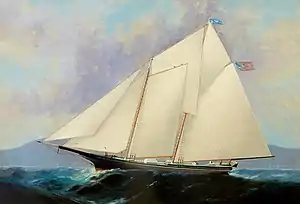James M. Waterbury (pilot boat)
The James M. Waterbury, or J. M. Waterbury, was a 19th-century Sandy Hook pilot boat built in 1843, at Williamsburgh, Brooklyn for the New York Pilots. She helped on many of the rescues along the New York Harbor.
 Pilot schooner James M. Waterbury by Elisha Taylor Baker. | |
| History | |
|---|---|
| Name: | James M. Waterbury |
| Namesake: | James M. Waterbury |
| Owner: | Orden & Roberts, New York pilots |
| Operator: | Thomas Morely (1871–1873) |
| Completed: | 1843 |
| Out of service: | After 1867 |
| Homeport: | New York |
| General characteristics | |
| Class and type: | Schooner |
| Displacement: | 43 tons TM |
| Length: | 76 ft 0 in (23.16 m) |
| Draft: | 9 ft 0 in (2.74 m) |
| Propulsion: | sails |
| Sail plan: | Schooner-rigged |
Construction and service
The schooner James M. Waterbury, pilot boat was built in 1843, at Williamsburgh, Brooklyn for a group of New York Pilots. She was registered with the Record of American and Foreign Shipping from 1871 to 1873 to Captain Thomas Morely as Master; Orden & Roberts as owners, built in 1843; hailing from the port of New York. Her dimensions were 76 ft. length on deck; 9 ft. draft; 8 ft. and 76-tons burthen.[1]
One of the first reports of the Waterbury, appears on September 20, 1843, when the pilot boat James M. Waterbury, was informed that the ship Vespasian, had gone ashore in the fog, ten miles North of Barnegat Lightship. The ship had bilged with six feet of water in her cargo hold.[2]
On May 11, 1852, the pilot boat James M. Waterbury, came across the British ship Kate, seventy miles off Sandy Hook, that was in a bad storm and started to leak. The captain and most of the crew had already abandoned her. Pilot M. Macarthy, from the pilot boat, was put on board the Kate, and then went to get assistance in her rescue. The Achilles towed her safely into port.[3]
In 1860, the James M. Waterbury, was one of only twenty-one pilot boats in the New York and New fleet. The boat number "10" was painted as a large number on her mainsail, that identified the boat as belonging to the Sandy Hook Pilots.[4] On October, 10, 1860, New York Sandy Hook Pilot Ralph Noble, of the pilot boat James M. Waterbury, No. 10, signed a statement along with other pilots, that they were satisfied with the representation they have received from the New York Board of Commissioners of Pilots.[5]
On April 11, 1864, the safety of the pilot boat James M. Waterbury, was reported in question when she was last seen with only one pilot on board, the rest having arrived in port in yawls.[6]
One of last reports of the pilot boat Waterbury, was on April 10, 1867, when seaman James Roach of Cork, Ireland, fell overboard and was drowned off Fire Island on board the New York pilot boat James M. Waterbury.[7]
References
- "Record of American and Foreign Shipping". Mystic Seaport Museum. New York. 1881. Retrieved 2020-10-14.
- "Disasters". New-York Tribune. New York, New York. 20 Sep 1843. p. 3. Retrieved 2021-01-27.
- "New York, April 27". Liverpool Mercury, etc. Liverpool, Merseyside, England. 11 May 1852. p. 7. Retrieved 2021-01-27.
- Russell, Charles Edward (1929). From Sandy Hook to 62°. New York: Century Co. p. 148, 159. OCLC 3804485.
- "The New York Pilots. To The Editor Of The Herald". New York Daily Herald. New York, New York. 10 Oct 1860. p. 2. Retrieved 2021-01-28.
- "The Storm of Yesterday". New York Times. April 11, 1864. p. 1.
- "Disasters". New York Daily Tribune. New York, New York. 13 Apr 1861. p. 5. Retrieved 2021-01-28.